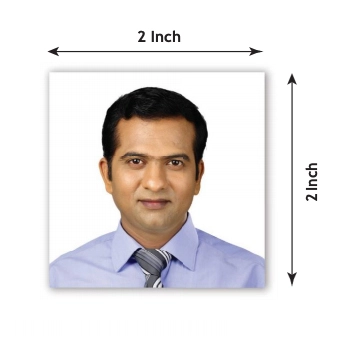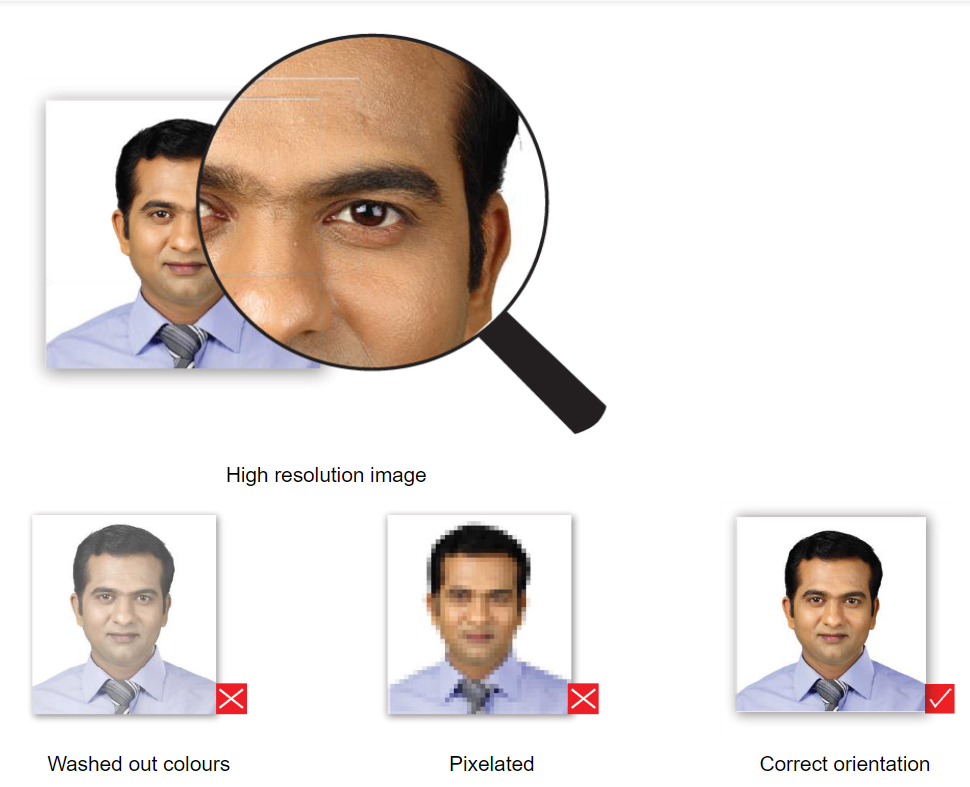The quality of the photograph appearing on the passport depends on the photograph that is submitted at the time of applying for a passport. The passport seekers are, therefore, advised to submit the photographs, as specified, to avoid delay in processing their passport applications.

- The photograph should be in color and of the size of 2 inch x 2 inch (51mmx 51mm).
- The photo-print should be clear and with a continuous-tone quality.
- It should have full face, front view, eyes open.
- Photo should present full head from top of hair to bottom of chin.
- Center head within frame.
- The background should be a plain white background.
- There should not be any distracting shadows on the face or on the background.
- The photograph must be taken in a colored attire, for example, a medium blue shirt etc.
- The attire should not be patterned/textured or pure white.
- Head coverings are not permitted except for religious reasons, but the facial features from bottom of chin to top of forehead and both edges of the face must be clearly shown.
- The expression on the face should look natural.
Do’s and Dont’s for a Proper photo
The photo should capture full face, front view, with eyes open. The head should be in the center of the frame. There should be no distracting shadows on the face or background.

Make sure photo presents full head from top of hair to bottom of chin; height of head should measure 1 inch to 3/8 inches (25 mm to 35 mm). Make sure eye height is between 1 1/8 inches to 1 1/3.
Lighting on face and background
The light should be even and balanced to avoid shadows on the face. Background behind the face should be properly illuminated to avoid shadows in the background.

Photograph Print Properties
The photograph should be in size 2 inch x 2 inch (51 mm x 51 mm) and in color. Print photo on thin photo paper or stock. Ensure the print is clear and has a continuous-tone quality. Do not retouch or otherwise enhance or soften the photo.

Resolution and Printing Quality
High-resolution photography and printing are strongly recommended. Both conventional and digital photography are acceptable, and conventional or digital printing methods may be used.

Resulting print should exhibit a continuous-tone quality regardless of the print method used (dye sublimation, ink jet, laser, etc.)
Digitally printed photos should be produced without visible pixels or dot patterns. Fine facial features should be discernible
Contrast and Colour
Brightness and contrast should be adjusted to present the subject and background accurately.
Photos without proper contrast or color may obscure unique facial features. Color should reproduce natural skin tones.
Fluorescent or other lighting with unbalanced color may cause unwanted color cast in photo. Appropriate filters can eliminate improper color balance.

Head & Eyes- Position and Background
Head should face the camera directly and should not tilt or turned (portrait style). Photo must show both edges of the face clearly.

Eyeglasses
Glare on eyeglasses should be avoided with a slight upward or downward tilt of the head. No tinted or dark glasses.

Head coverings
are not permitted except for religious reasons, but the facial features from bottom of chin to top of forehead and both edges of the face must be clearly shown.

Exposure and Lighting
There should not be any over-exposure or under-exposure which results in an unusable photo. There should be a three-point balanced lighting. Facial features should be clearly evident in the photo. Lighting should be adjusted to avoid shadows on the face or background. Diffuse sources of light, such as umbrella lights, are preferable to point sources.

Flexibility in Children’s photographs
Babies under one year do not have to have their eyes open. With regards to the photograph of the children under ten years of age, requirements can be somewhat relaxed in respect of height of the face, and the position of the eyes in the photographs; and in case of babies and infants also, the position of the face, the facial expression, the eyes and the line of sight can have some relaxation. However, a frontal photograph with clarity is required for children. It should show the child alone (no chair backs, toys or other people visible), looking at the camera with a neutral expression and the mouth closed.

No chair backs, toys or other people visible & no open mouth. Photographs taken with a digital camera should be of high quality color.
